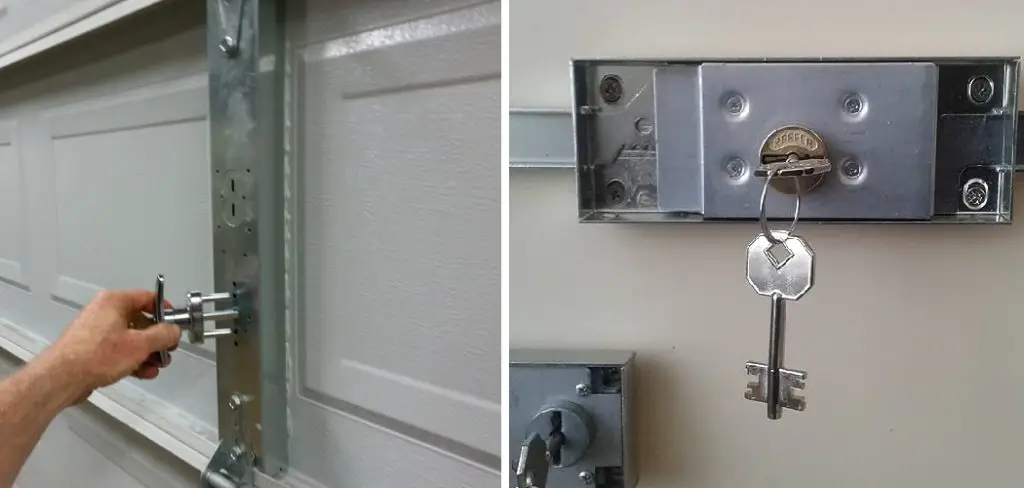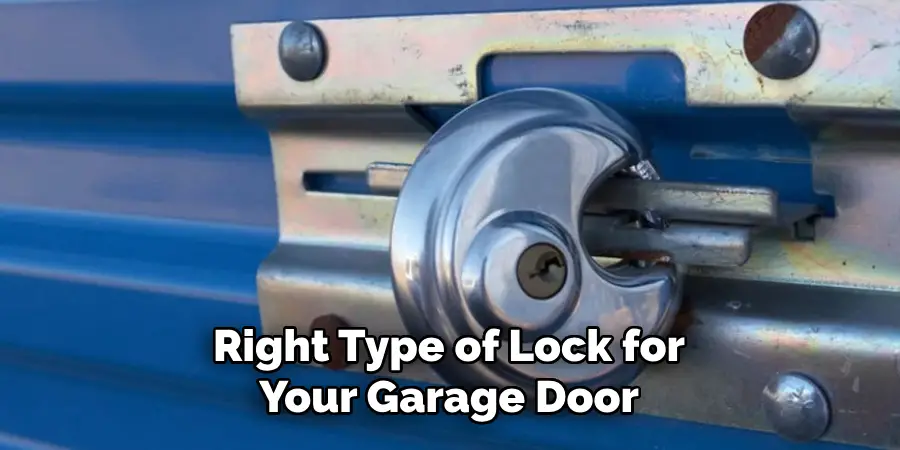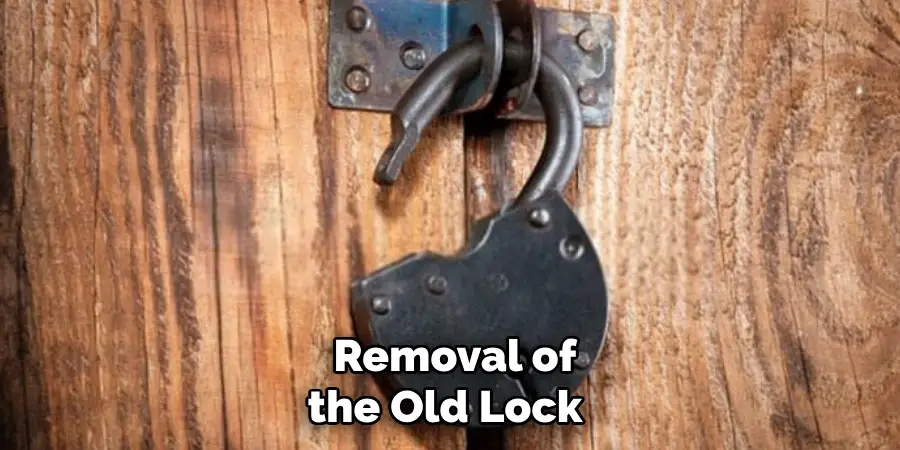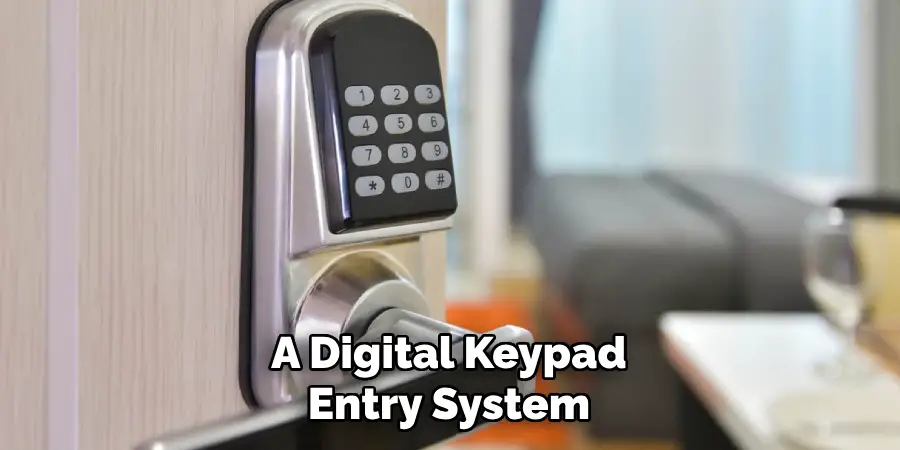Changing the lock on your garage door is a crucial step in maintaining the security of your property. Whether you’ve moved into a new home, lost a key, or simply want to upgrade your security measures, understanding how to change a garage door lock is invaluable. A properly functioning garage door lock provides peace of mind and helps safeguard your belongings.

In this article, we will guide you through the essential steps on how to change garage door lock. From choosing the right replacement lock to executing the process with precision, you’ll gain insights that empower you to enhance your home’s security effectively and efficiently.
What Kind of Lock Is on a Garage Door?
When it comes to garage door locks, there are two main types: keyed cylinders and deadbolts. Keyed cylinder locks can be opened with a key from the outside of the garage door, while deadbolts require a key to open them from both the inside and outside of the door. Deadbolt locks provide greater security than traditional keyed-cylinder locks, and are generally recommended for most garage doors.
Before you change the lock on your garage door, it’s important to know what type of lock is currently installed so that you can choose a compatible replacement. There are several easy ways to determine this:
- Check the manufacturer’s instructions or website for information about the lock.
- Visually inspect the lock: is it a keyed cylinder or deadbolt?
- If you are able to remove the old lock, look inside for any identifying marks that indicate the type of lock.
Once you have identified your current garage door lock, you can move on to selecting and installing a compatible replacement. This process will vary depending on the type of lock and make/model, so consult the manufacturer’s instructions for specific details.
When it comes to choosing a replacement garage door lock, you should look for one that is easy to operate, reliable, and provides an appropriate amount of security for your needs. If you are uncertain which type or model is best suited to your garage door, consider consulting with a locksmith who can help you select the right lock for your needs.
The Importance of a Secure Garage Door Lock for Home Safety
Having a secure garage door lock is essential for the safety and security of your home. It prevents intruders from entering your property, while also ensuring that any valuable items stored in the garage are kept safe. Changing your garage door lock regularly can help to further protect your home against potential burglars or other unauthorized access. In this article we’ll look at how to change a garage door lock quickly and easily.
First, you’ll need to find the right type of lock for your garage door. There are many different types available, so it’s important that you choose one that is strong and reliable. You should also check whether the lock is compatible with your existing hardware before purchasing it.

Next, you’ll need to remove the old garage door lock. Begin by unscrewing the screws that hold the knob or handle in place. Once these are removed, you can carefully pull off the knob or handle and take out the existing lock cylinder from its housing.
Now it’s time to install your new lock. Start by putting the new cylinder in place and making sure that it’s secure. Then, attach the knob or handle to the door using the screws that were removed earlier. Finally, you can check that everything is working properly by trying out the new lock before closing up your garage door.
10 Steps How to Change Garage Door Lock
Step 1: Assemble the Necessary Tools and Materials
Embarking on the journey of changing your garage door lock necessitates thorough preparation. Ensure that you have all essential tools and materials at your disposal. This inventory might encompass a compatible replacement lockset, an assortment of screwdrivers, pliers, a tape measure, a reliable drill, drill bits, an assortment of screws, and potentially an extra pair of hands if the task warrants assistance.
Step 2: Delve into Lock Selection
Empower yourself by meticulously delving into the realm of lock selection. Factors such as the type of garage door (manual or automatic), the level of security you aspire to achieve, and your preference for either traditional key-based mechanisms or state-of-the-art digital keypad systems should guide your decision.
Step 3: Scrutinize the Existing Lock
Before commencing the transformation, a meticulous examination of the prevailing lock is paramount. This scrutiny enables a deeper understanding of the current configuration and aids in devising an effective plan for the removal of the old lock and the installation of its successor.

Step 4: Safely Disengage the Garage Door Opener
For garages equipped with automatic openers, prioritize your safety by disengaging the power supply. This precaution ensures a secure environment as you embark on the process of changing the lock.
Step 5: Bid Adieu to the Old Lock
With due caution, employ a screwdriver to gingerly undo the screws anchoring the existing lock. The approach may vary depending on the specific lock type, potentially requiring you to remove a faceplate or cover to access and manipulate the mounting screws.
Step 6: Measure and Prepare Anew
Prior to embarking on the installation of the new lock, meticulous measurement is indispensable. Verify that the dimensions of the lockset align seamlessly with the existing holes in the garage door. If adjustments are required, employ a template provided by the manufacturer to judiciously mark the accurate drilling points.
Step 7: Drill with Precision
Should the new lock necessitate a different hole configuration, wield a drill accompanied by an appropriate drill bit to create fresh openings. Adhere meticulously to the manufacturer’s guidelines or the template, ensuring that the drilling is conducted precisely and maintains the proper depth.
Step 8: Graceful Installation of the New Lockset
Gingerly insert the new lockset through the meticulously drilled holes. Exercise care to ascertain a snug fit. Bolster its placement with the application of the provided screws, conscientiously adhering to the manufacturer’s stipulated installation directives.
Step 9: Evaluate and Reconnect the Opener
With the installation nearing completion, undertake a thorough evaluation of the new lock’s functionality. Engage in the process of locking and unlocking the door utilizing both the key and the internal mechanism. If your garage door features an automatic opener, reconnect it to the power source, priming it for seamless operation.
Step 10: Pivotal Final Touches – Key Duplication and Code Setting
Should your chosen lock involve traditional keys or a digital keypad entry system, recognize the significance of duplicating keys and configuring access codes. Prudently secure spare keys in a safe location and exercise discretion in sharing access codes, reserving this privilege for individuals you wholeheartedly trust.

Things to Consider When Changing Garage Door Lock
It is essential to consider a few factors before changing your garage door lock. When choosing the right garage door lock, make sure it fits your existing hardware. It is important to check compatibility between the new and old locks, as different sizes of locks may be required for different models of doors or gate systems. Additionally, think about what type of mechanism you need; keyed locks, keyless entry systems, or a combination of both.
Be sure to consider the security features of your garage door lock as well. Upgrading your current lock may require additional hardware and installation services. Look for deadbolts that come with anti-drill plates or external relocker mechanisms to provide added protection against break-in attempts. Make sure you also check to see if the lock is certified as meeting certain security standards.
If you are using a keyless entry system, keep in mind that they may be vulnerable to hacking attempts. Make sure you have chosen a secure code and avoid writing it down or sharing it with anyone else. Lastly, keep your manual handy so that you can refer to it in case any issues arise.
Safety Precautions for Changing Garage Door Lock
Changing the lock on your garage door is an important step for protecting your home. To perform this task safely, it’s important to have a few safety precautions in place. Follow these steps for maximum security when changing out the lock of your garage door:

- Make sure you’re wearing gloves and protective eyewear when replacing the lock on your garage door. This will help to prevent any cuts or scrapes that can occur during the process.
- Have a friend stand by in case you need assistance while changing out the lock. They should also be wearing protective gear, such as gloves and eye protection, for their own safety.
- When you’re ready to begin working on your garage door, be sure to disconnect the power source. This will prevent any electrical shocks that can occur if you accidentally come into contact with a live wire while undoing the old lock.
- Once the power is disconnected, remove the old lock from your garage door. You may need a drill or other tools in order to do this safely and correctly.
Conclusion
Completing this task not only gives you peace of mind in knowing the security of your home was improved, but it also allows you to have more control over who has access to your garage. Not only that, but having a secure lock could even pay off if there were any accidents or medical emergencies on your property.
Knowing how to change garage door locks is an excellent tool to have for any homeowner. If done properly, the process should be safe and straightforward; if difficulties arise, however, it is – as always – best to consult a professional. Ultimately, the new lock provides you with increased safety and allows you the freedom to adjust your security measures according to changes in circumstance.
